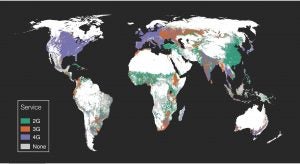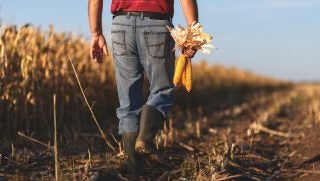Farmers around the world are missing out on the everyday technology that helps power the spread of information, commerce, entertainment, and even family relationships — broadband internet. Smaller farmers, particularly those in developing countries, are most at risk, according to the latest published research. The tally of those unconnected globally is projected at hundreds of millions farmers, and to make matters worse, the advent of 5G is likely to deepen the divide between the haves and the have nots.
While digital technologies are steadily reaching more farmers, for each one plugged into the latest weather forecast or selling produce at the tap of a screen, millions more are sidelined as the digital revolution whizzes by. Smartphones with the right apps can tell farmers when it’s likely going to rain, how to identify and eradicate pests, and negotiate the prices for a bountiful harvest delivered by a combination of hard work and big data. Imagine trying to compete in the modern era without those tools at your fingertips.
Those of us in the U.S. and Canada are arguably the luckiest on this front. Maps for Wi-Fi locations in rural America are being made available, ag-friendly corporations and cooperatives have put broadband expansion high on their priority list, and as recently as October, the Federal Communications Commission launched its Rural Digital Opportunity Fund auction, which will provide internet companies with $20 billion in subsidies over the next 10 years to build out broadband networks in underserved parts of the country.

Elsewhere around the world — which is important because, now more than ever, agriculture is a global industry — the news is more dire.
Across many locations in sub-Saharan Africa, which has the potential to be a global breadbasket, fewer than 40 percent of farming households have internet access. And unlike Asia and Latin America, where mobile phone ownership is nearly universal, fewer than 70 percent of farmers in sub-Saharan Africa have handheld devices. And access to 4G networks required to run more sophisticated apps is only 9 percent.
“There’s an assumption that we’re going to be able to target everyone with these new technologies and everyone is going to be able to benefit,” said Zia Mehrabi, a scientist at the University of British Columbia who led the analysis published Nov. 2 in Nature Sustainability.
The study also showed major differences between farm size and mobile network services. Globally, 24 percent to 37 percent of farms under 2.5 acres (one hectare) had access to 3G or 4G networks. Service availability is as high as 80 percent for farms over 200 hectares.
2G technology, which provides voice and text service, has wider availability but is not compatible with most smartphone technology.
“We face a digital poverty trap — those who are already marginalized fall further behind while others benefit from the myriad of opportunities offered by digital innovation in farming,” said Andy Jarvis, a co-author from the Alliance of Bioversity International and CIAT, who is also part of the CGIAR Platform for Big Data in Agriculture.
The researchers’ affordability analysis found that for many rural poor who do live in areas with coverage, getting connected could eat up the majority of their household budget.
“The study points to the need not only to expand coverage but vastly reduce the costs to make it affordable,” said Jarvis. “We need to consider digital connectedness as a basic need, and design next-generation innovations to work in every corner of Africa.”
Noise but no signal
The study zeroed in on mobile coverage gaps where farmers need it most.
In nitrogen-deficient cropping areas, which have low yields without proper fertilizer management, 3G/4G availability was 60% and 22% respectively. Areas dependent on rainfall for production had 71 percent and 54 percent availability. For arid environments, which pose large but surmountable production challenges, coverage was only 37% and 17%.
“These coverage gaps pose important roadblocks for developing data-hungry nutrient advisories, climate services, and financial services that require mobile internet,” the authors said.
As for people affected by food insecurity, which is based on the prevalence of childhood stunting, 3G/4G coverage was 61 percent/45 percent and, in Africa, 52 percent/22 percent. Global access for people afflicted by malaria, which caused more than 400,000 deaths in 2018, is only 37 percent/17 percent.
“This lack of coverage for at-risk populations poses serious concern for responding to food security and health impacts of emerging diseases including COVID-19. This lack of coverage is more problematic today than ever before,” said Mehrabi.
Universal broadband
The authors call on governments, businesses, development agencies and global philanthropists to quickly mobilize the investments and interventions needed to close the digital divide. They call for immediate action on The United Nations Sustainable Development Goal, which outlines universal access to the Internet in least developed countries by 2020.
Proposed actions include:
- Investment in “last-mile” infrastructure innovations such as renewable energy, low-cost mobile towers, and backhaul technologies like scalable microwave technologies.
- Increase in handset affordability: devices in emerging markets are in the USD $100 range, making them unaffordable for many, including women who have lower handset ownership than men in many regions.
- Make data access universal: even if they have handsets, the poorest farmers are unable to afford data. In some African countries, a basic plan with 1GB of data per month exceeds the annual income of the poorest 10% of the population.
- Use interim solutions: SMS advisories and voice message services on existing 2G networks offer significant opportunities for productivity, market connectivity, money transfers, credit and other services – as long as they have sophisticated back-end support.
- Research funding: this baseline study should be regularly updated to keep track of progress and build metrics related to capacity building, skills, digital literacy and cultural appropriateness of services, particularly across ages and genders.
“There’s a lot of 5G coming online. If access is not addressed at lower-end technologies, this is only going to aggravate the divide and create more inequality,” said Mehrabi.
Become an ag insider with AGDAILY!
We deliver quality over quantity. Sign up here!


